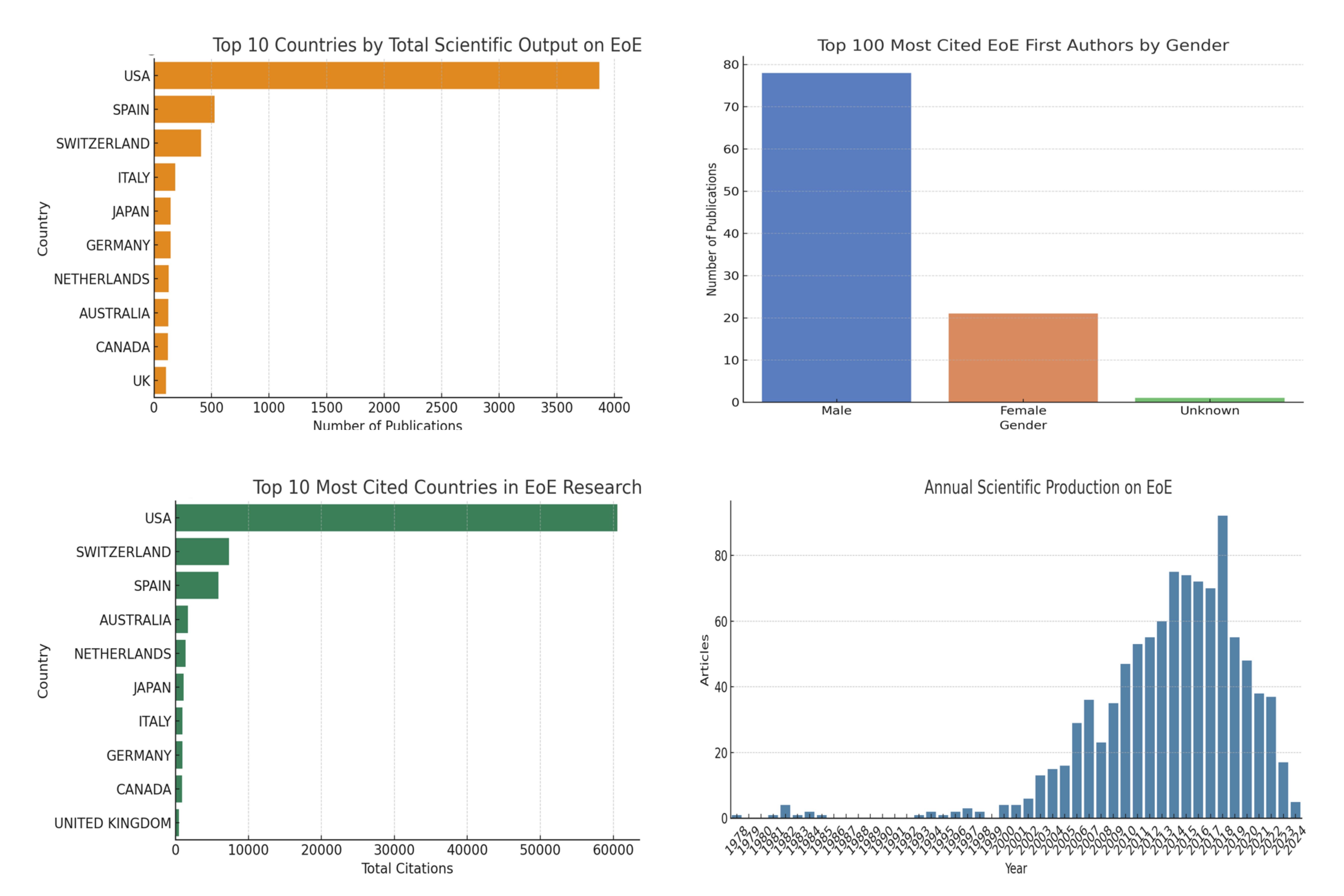Sunday Poster Session
Category: Esophagus
P0645 - Global and Temporal Trends in Eosinophilic Esophagitis (EoE) Research: A Bibliometric Analysis of Geographic Disparities
Sunday, October 26, 2025
3:30 PM - 7:00 PM PDT
Location: Exhibit Hall

Renan Prado, MD
Cleveland Clinic Foundation
Cleveland, OH
Presenting Author(s)
Renan Prado, MD1, Melissa Lou Silva, MD2, Julia Tirelli Rocha, MD3
1Cleveland Clinic Foundation, Cleveland, OH; 2University of California San Diego, San Diego, CA; 3Jundiai Medical School, Jundiai, Sao Paulo, Brazil
Introduction: Despite the growing clinical recognition of eosinophilic esophagitis (EoE), disparities in the global dissemination of research on this condition remain insufficiently explored. As bibliometric patterns often reflect deeper inequalities in research infrastructure, funding, and opportunity, understanding such disparities in EoE publications may provide insight into global access to knowledge generation and therapeutic advances. This study aim to evaluate global publication trends to the 1,000 most cited articles related to EoE.
Methods: A bibliometric analysis was conducted using the Web of Science Core Collection (WoSCC). The 1,000 most cited studies on EoE published between 1978 and 2024 were included for evaluation. Meeting abstracts were excluded. Bibliometric indicators were calculated using the Bibliometrix package in R. Parameters assessed included publication trends, citation metrics and geographic distribution.
Results: A total of 1,000 EoE-related publications from 165 sources were identified. The annual growth rate was 3.56%, and the average article age was 11.3 years. Each document received an average of 84.78 citations, reflecting strong academic impact. The most prolific journals were Journal of Allergy and Clinical Immunology (n=97), Clinical Gastroenterology and Hepatology (n=81), and Journal of Pediatric Gastroenterology and Nutrition (n=69). The USA led in corresponding authorship (655 articles, 65.5%), followed by Spain (7.6%) and Switzerland (6.0%). International collaborations were relatively limited, with the USA having only 12.7% multi-country publications. Among the top 5 most globally cited articles, three originated from the USA, with the most cited article with 1,581 citation. All the top 10 countries contributing to EoE research are from developed nations. Only 2.7% of global EoE publications across the top 100 cited articles originated from developing countries. Also, among the top 100 most cited, less than 25% had a female as first author.
Discussion: Our findings reveal notable disparities in global EoE research output, with a dominant contribution from the USA and underrepresentation from low- and middle-income countries. These disparities may reflect broader imbalances in research opportunity and access to scientific infrastructure. Enhanced collaboration and targeted capacity-building efforts are needed to promote more equitable global representation in EoE research.

Figure: EoE Publications (Location, Sex and Temporal evaluation)
Disclosures:
Renan Prado indicated no relevant financial relationships.
Melissa Lou Silva indicated no relevant financial relationships.
Julia Tirelli Rocha indicated no relevant financial relationships.
Renan Prado, MD1, Melissa Lou Silva, MD2, Julia Tirelli Rocha, MD3. P0645 - Global and Temporal Trends in Eosinophilic Esophagitis (EoE) Research: A Bibliometric Analysis of Geographic Disparities, ACG 2025 Annual Scientific Meeting Abstracts. Phoenix, AZ: American College of Gastroenterology.
1Cleveland Clinic Foundation, Cleveland, OH; 2University of California San Diego, San Diego, CA; 3Jundiai Medical School, Jundiai, Sao Paulo, Brazil
Introduction: Despite the growing clinical recognition of eosinophilic esophagitis (EoE), disparities in the global dissemination of research on this condition remain insufficiently explored. As bibliometric patterns often reflect deeper inequalities in research infrastructure, funding, and opportunity, understanding such disparities in EoE publications may provide insight into global access to knowledge generation and therapeutic advances. This study aim to evaluate global publication trends to the 1,000 most cited articles related to EoE.
Methods: A bibliometric analysis was conducted using the Web of Science Core Collection (WoSCC). The 1,000 most cited studies on EoE published between 1978 and 2024 were included for evaluation. Meeting abstracts were excluded. Bibliometric indicators were calculated using the Bibliometrix package in R. Parameters assessed included publication trends, citation metrics and geographic distribution.
Results: A total of 1,000 EoE-related publications from 165 sources were identified. The annual growth rate was 3.56%, and the average article age was 11.3 years. Each document received an average of 84.78 citations, reflecting strong academic impact. The most prolific journals were Journal of Allergy and Clinical Immunology (n=97), Clinical Gastroenterology and Hepatology (n=81), and Journal of Pediatric Gastroenterology and Nutrition (n=69). The USA led in corresponding authorship (655 articles, 65.5%), followed by Spain (7.6%) and Switzerland (6.0%). International collaborations were relatively limited, with the USA having only 12.7% multi-country publications. Among the top 5 most globally cited articles, three originated from the USA, with the most cited article with 1,581 citation. All the top 10 countries contributing to EoE research are from developed nations. Only 2.7% of global EoE publications across the top 100 cited articles originated from developing countries. Also, among the top 100 most cited, less than 25% had a female as first author.
Discussion: Our findings reveal notable disparities in global EoE research output, with a dominant contribution from the USA and underrepresentation from low- and middle-income countries. These disparities may reflect broader imbalances in research opportunity and access to scientific infrastructure. Enhanced collaboration and targeted capacity-building efforts are needed to promote more equitable global representation in EoE research.

Figure: EoE Publications (Location, Sex and Temporal evaluation)
Disclosures:
Renan Prado indicated no relevant financial relationships.
Melissa Lou Silva indicated no relevant financial relationships.
Julia Tirelli Rocha indicated no relevant financial relationships.
Renan Prado, MD1, Melissa Lou Silva, MD2, Julia Tirelli Rocha, MD3. P0645 - Global and Temporal Trends in Eosinophilic Esophagitis (EoE) Research: A Bibliometric Analysis of Geographic Disparities, ACG 2025 Annual Scientific Meeting Abstracts. Phoenix, AZ: American College of Gastroenterology.
